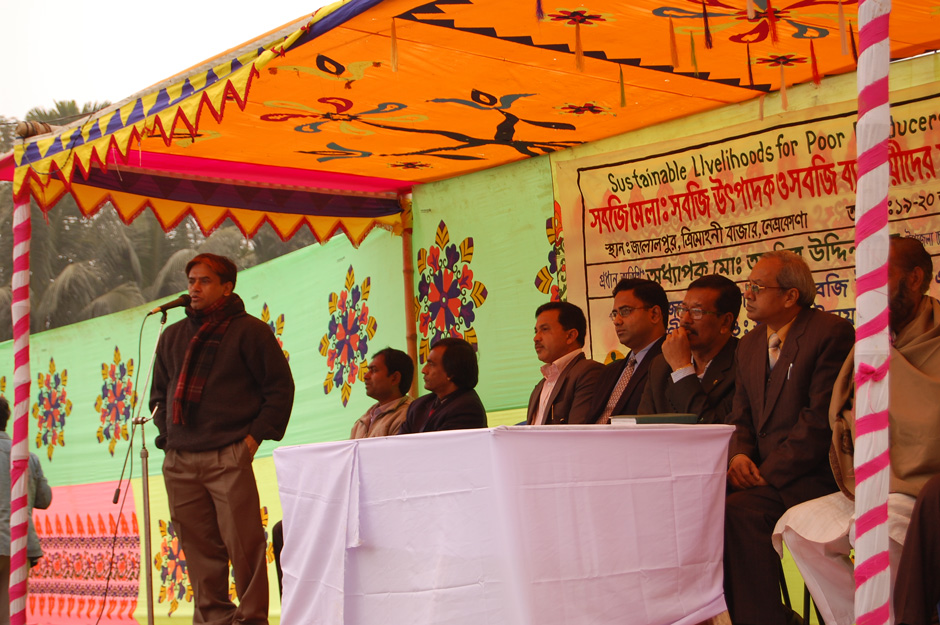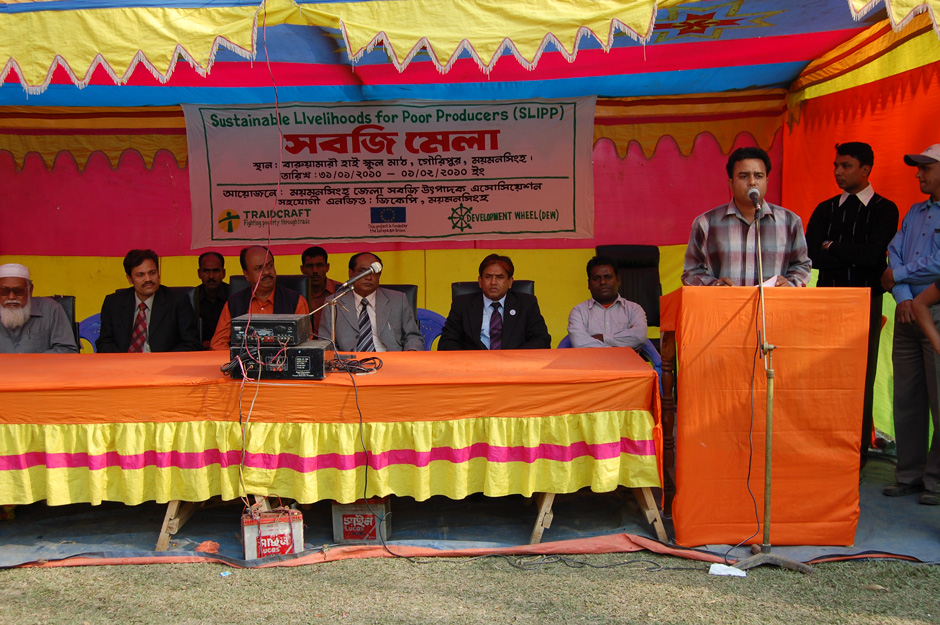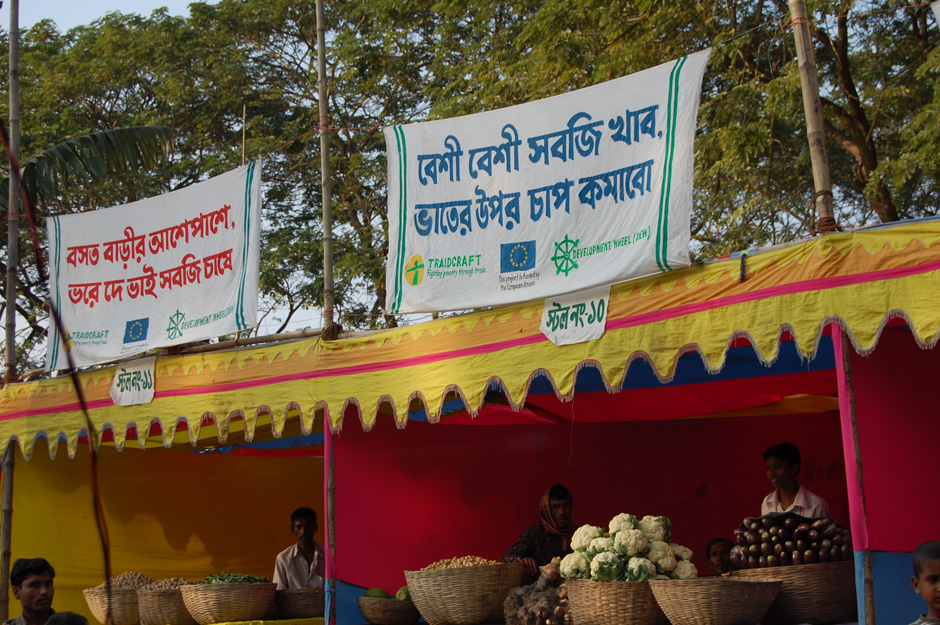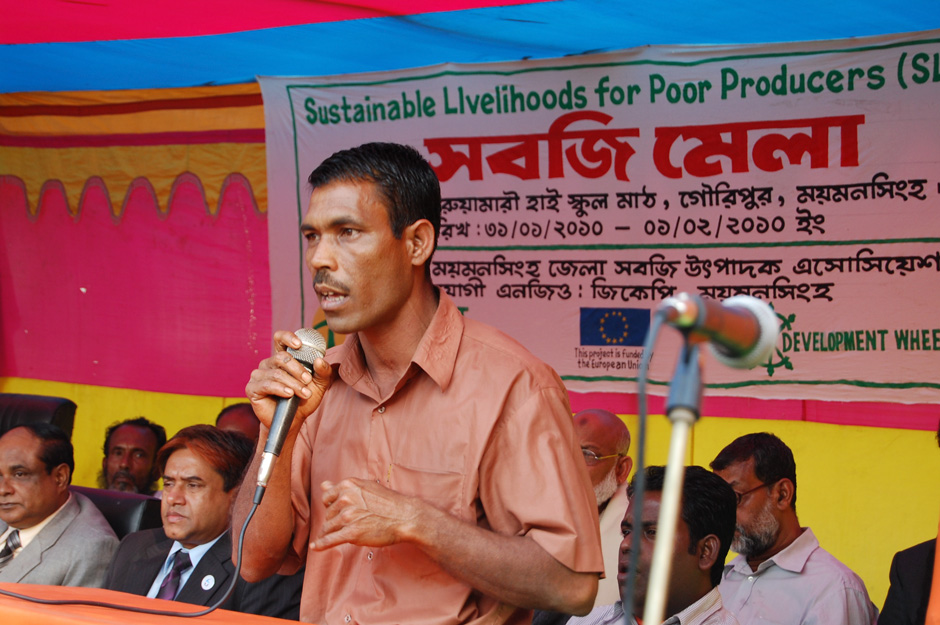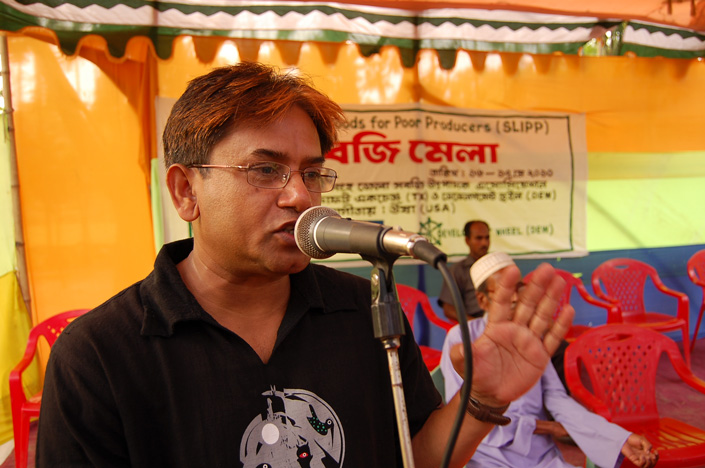The Sustainable Livelihoods for Poor Producers in Mymensingh and Netrokona (SLIPP) in Mymensingh and Netrokona project was incepted on January 1st 2007 with the aim to increase income, employment and sustainable livelihood for 1200 beneficiaries in vegetable, duck and fish sector. Poor access and knowledge of business services led to inefficient business process resulting in low income and poverty. The project addressed these issues by working with relevant stakeholders to improve knowledge and linkages between beneficiaries and value chain actors. The project is funded by EU and co-founded by TraidCraft Exchange. It has been implemented by Development Wheel, a national NGO, in collaboration with 8 partner NGOs for field-level implementation. TraidCraft provided the technical direction to the project. This evaluation was conducted to gauge the project’s performance against five criteria: relevance, efficiency, effectiveness, impact and sustainability. Based on the findings, key lessons were drawn, leading to recommendations. Methodology entailed Key Informant Interviews, Focus Group Discussions with 15 farmer groups and impact survey on 195 beneficiaries from the three subsectors the findings from which were later validated at the district and the national level.
Based on the evaluation it can be concluded the project had a clear strategic road map that addresses (what) sector/ value chain level dysfunctions, (how) by building competitiveness of the MSEs (for what) to achieve improved enterprise performance that increases income, creates jobs and improves livelihood of the targeted beneficiaries. The conceptual framework of the project allowed for addressing key constraints in the selected subsectors (poor access to business services, inefficiency in the supply chain, unfavourable business environment) which could result improved enterprise performance (increase in productivity, lower cost of operations, higher market price) and contribute to poverty alleviation (by increasing income, improving livelihood, child nutrition, increased access to health and education). The interventions undertaken by SLIPP rightly identified the need for increasing access to knowledge and information (by improving the linkages with the value chain actors) and sustaining it through increased institutional capacity of the farmers (by forming farmer groups).
SLIPP’s interventions had immediate impact on increasing income and improving livelihood of the targeted beneficiaries in all the three subsectors. However, SLIPP had comparatively less impact and control on creating jobs in fisheries and in the duck subsector. The region boasts the largest fisheries clusters in the country with hundreds of large commercial scale fish farms which have a huge push and pull affect on the value chain that outweighs the impact that could be created by SLIPP in creating jobs by working with 450 small scale fish farms spread across 18 groups in several districts. Duck rearing is concentrated at household level and involves household labor instead of hired labor. In comparison vegetable farmers employ large number of labors at the farm level in production and harvesting. Thus, the impact on increased production and productivity in the vegetable subsector is rapid and can clearly be attributed to the interventions of SLIPP. With the exception of job creation, we find the selected subsectors relevant to the objectives of SLIPP.
SLIPP strategically partnered with the public sector (for example SRDI) and the private sector (for example Syngenta and Renata), engaged with both public (agricultural extension officers) and private service providers (input retailers) and strengthened the capacity of the farmer groups (by working with local change agents or leaders). This increased the effectiveness of the interventions in terms of ownership of the beneficiaries and sustainability of the impacts. But the efficiency of the project was affected by rapid expansion of project outreach (2500 against the targeted 1200). SLIPP rapidly expanded the number of farmer groups (100 against the target of 48) and number of target beneficiaries at the later stage (after mid-term) of the project because of the need for a feasible customer base for business services that were promoted by SLIPP and also by the demands of the beneficiaries themselves. The groups formed at a later stage did not show the similar responsiveness and capacities as did the groups formed at the early stage of the project. We highly recommend that projects that aim at working with farmer groups through a market facilitation approach plan for larger outreach right at the inception of the project. Also, it is essential to have a scale-up strategy from the beginning of the project that clearly shows the transition from pilot to scale-up and the milestones that will trigger the transition.
Efficiency of the project was also affected because of high staff turn-over and limited staff capacity of TraidCraft, Development Wheel and the 8 partner NGOs. The partnership with the local NGOs was based on voluntary agreement because of which the PNGO staffs did not prioritize field monitoring of the SLIPP groups and interventions. Besides, because of high turn over the staffs could not be provided proper induction on the project’s approach, goal and objectives and the interventions. The field staffs were more focused on organizing trainings and lacked conceptual clarity on ensuring knowledge dissemination amongst the group members sustaining the capacity of the groups and the linkages between the value chain actors. Furthermore, group formation strategy requires time and monitoring– which became difficult as the number of groups increased rapidly with no increase in project’s manpower. Market facilitation projects strive on human resources. It is thus essential that the projects are given sufficient funds to recruit and retain competent staffs and ensure staff development as a continuous process. Also, partnership with PNGOs should be directed by milestones and full time engagement rather than voluntary engagement.
In all the three subsectors SLIPP opted to intervene in the input supply and production systems (scope to generate quick results) instead of market access (dependent on external macroeconomic factors). The strategy to prioritize quick win interventions proved to be effective in building trust amongst the beneficiary groups which was required for later interventions with long-term benefits like building linkages with supply chain actors and ensuring market access. However, the project intervened in the interventions related to market access at a very late stage (end of 4th year) because of which the impacts could not be scaled up.
Better access to services has been ensured especially from supply-chain and support actors. Soil testing and ensuing balanced fertilization along with use of micronutrients and compost benefited the vegetable farmers significantly, while medicine and vaccination training and access to veterinary services reduced mortality rates among duck farmers. For fish farmers, access to better quality fish seed, developed via training to hatcheries, improved their produce. Developing linkages with SAAOs and other government officers proved most beneficial to farmers as a source of information about business services as well as increasing their negotiation power with supply chain and market actors. Overall, the beneficiaries in all the subsectors have benefitted from higher productivity and lower cost of production. However, improvements in market linkages have been sporadic primarily because the interventions were undertaken at a late stage of the project.
Increase in income from vegetable production for the SLIPP beneficiaries in Mymensingh and Netrokona (respectively 52% and 78%) was found to be much higher than the increase in income from vegetable production for the control group farmers (respectively 20% and 22%). Income of the SLIPP beneficiaries from fisheries increased by 62% increase in comparison to 21% increase in income of the control group farmers while income of the SLIPP beneficiaries from duck rearing increased by 71% in comparison to the 26% increase in income of the control group. The increase in income has helped to improve livelihood as the households reported increased expenditure on education and health care. But, the interventions of SLIPP in vegetable subsector had more impact on job creation (respectively 36% and 27% increase in jobs in Mymensingh and Netrokona) than the interventions in fisheries subsector (13% increase in jobs) and the interventions in the duck subsector (no substantial change reported).
The biggest success of SLIPP is that it was able to generate local ownership as the groups were empowered to participate in the decision making process. The members in general feel proud of their activities, are more aware about their rights, have improved network and relationship with public and private service providers. The members of the groups understand the benefit of the groups and some of the older groups have started to take initiatives with indirect support (ideas) from SLIPP. This includes direct and bulk sales to traders, lobbying for bridge to increase market access, lobbying for irrigation facilities etc. Nevertheless, from the interaction with the group leaders and members it was observed that most of the groups still need external support to organize, to brainstorm and to interact amongst themselves. This necessitates a larger forum of the groups which could own and direct the groups once SLIPP has phased out. SLIPP has initiated the process of forming an association that would represent all the groups that were formed and facilitated by SLIPP. The process has not been completed but it is expected that the group leaders will effectively pursue the process. DAE under the NATP project has listed some of the vegetable farmer groups under CIG scheme and it is expected that most of the vegetable farmer groups will become involved in CIG.
Formation of the groups has largely facilitated public and private service delivery. It is more convenient for public extension service providers (for example Sub Assistant Agricultural Officers or SAAOs and the Soil Resource Development Institute) and private service providers (soil testers, input retailers etc.) to trace and target the farmers organized in groups rather than individual farmers. This mutual benefit will play a large role in sustaining the groups and the relationship between the groups and the public and private extension service providers.
Based on the findings from the evaluation we conclude that SLIPP has mostly achieved its targets of increasing income and improving livelihood. It has been widely successful in generating social capital and empowering farmer groups while it has paved the way to ensure sustained access to markets and business services. But the project did not have much impact on gender empowerment and gender inclusiveness. While the project’s interventions on compost technology and fertilization based on soil testing are relevant to sustainable agriculture and environmental responsiveness, it did not have role in strengthening the capacity of the farmers to cope with change in seasonality and change in cropping patterns arising from climate change and disasters like flash flood and drought. Major weakness of the project lies on its operations. The project’s strategy for rapid expansion was not in line with the project’s capacity. This together with the loosely defined partnership arrangement with the PNGOs resulted weak field monitoring and reduced the depth of impacts particularly with new groups and groups in remote areas. The transition from pilot to scale up and the interventions on market access were done at a late stage which reduced effectiveness.
Learning from these, we conclude that the SLIPP model for market facilitation could be much more effective at a larger scale where the project have the capacity to recruit, train and retain competent staffs, have the ability to effectively engage local partners and transfer knowledge and capacity to the partners to manage farmer groups. Besides, since empowerment of the farmer groups lies at the heart of the project, it would be essential to ensure the governance structure of the groups from the very onset of the project so that the groups have self sufficiency to operate effectively and ensure participation of larger number of farmer groups without support from the project. Most importantly, it will ensure a clearer exit strategy for the project.
